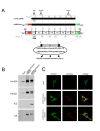pARIS-htt: an optimised expression platform to study huntingtin reveals functional domains required for vesicular trafficking
- PMID: 20515468
- PMCID: PMC2887845
- DOI: 10.1186/1756-6606-3-17
pARIS-htt: an optimised expression platform to study huntingtin reveals functional domains required for vesicular trafficking
Abstract
Background: Huntingtin (htt) is a multi-domain protein of 350 kDa that is mutated in Huntington's disease (HD) but whose function is yet to be fully understood. This absence of information is due in part to the difficulty of manipulating large DNA fragments by using conventional molecular cloning techniques. Consequently, few studies have addressed the cellular function(s) of full-length htt and its dysfunction(s) associated with the disease.
Results: We describe a flexible synthetic vector encoding full-length htt called pARIS-htt (Adaptable, RNAi Insensitive &Synthetic). It includes synthetic cDNA coding for full-length human htt modified so that: 1) it is improved for codon usage, 2) it is insensitive to four different siRNAs allowing gene replacement studies, 3) it contains unique restriction sites (URSs) dispersed throughout the entire sequence without modifying the translated amino acid sequence, 4) it contains multiple cloning sites at the N and C-ter ends and 5) it is Gateway compatible. These modifications facilitate mutagenesis, tagging and cloning into diverse expression plasmids. Htt regulates dynein/dynactin-dependent trafficking of vesicles, such as brain-derived neurotrophic factor (BDNF)-containing vesicles, and of organelles, including reforming and maintenance of the Golgi near the cell centre. We used tests of these trafficking functions to validate various pARIS-htt constructs. We demonstrated, after silencing of endogenous htt, that full-length htt expressed from pARIS-htt rescues Golgi apparatus reformation following reversible microtubule disruption. A mutant form of htt that contains a 100Q expansion and a htt form devoid of either HAP1 or dynein interaction domains are both unable to rescue loss of endogenous htt. These mutants have also an impaired capacity to promote BDNF vesicular trafficking in neuronal cells.
Conclusion: We report the validation of a synthetic gene encoding full-length htt protein that will facilitate analyses of its structure/function. This may help provide relevant information about the cellular dysfunctions operating during the disease. As proof of principle, we show that either polyQ expansion or deletion of key interacting domains within full-length htt protein impairs its function in transport indicating that HD mutation induces defects on intrinsic properties of the protein and further demonstrating the importance of studying htt in its full-length context.
Figures






Similar articles
-
Mutant Huntingtin alters retrograde transport of TrkB receptors in striatal dendrites.J Neurosci. 2013 Apr 10;33(15):6298-309. doi: 10.1523/JNEUROSCI.2033-12.2013. J Neurosci. 2013. PMID: 23575829 Free PMC article.
-
Huntingtin facilitates dynein/dynactin-mediated vesicle transport.Proc Natl Acad Sci U S A. 2007 Jun 12;104(24):10045-50. doi: 10.1073/pnas.0610628104. Epub 2007 Jun 4. Proc Natl Acad Sci U S A. 2007. PMID: 17548833 Free PMC article.
-
Phosphorylation of mutant huntingtin at S421 restores anterograde and retrograde transport in neurons.Hum Mol Genet. 2008 Dec 15;17(24):3837-46. doi: 10.1093/hmg/ddn281. Epub 2008 Sep 4. Hum Mol Genet. 2008. PMID: 18772195
-
[Huntington's disease: intracellular signaling pathways and neuronal death].J Soc Biol. 2005;199(3):247-51. doi: 10.1051/jbio:2005026. J Soc Biol. 2005. PMID: 16471265 Review. French.
-
Transcriptional dysregulation of coding and non-coding genes in cellular models of Huntington's disease.Biochem Soc Trans. 2009 Dec;37(Pt 6):1270-5. doi: 10.1042/BST0371270. Biochem Soc Trans. 2009. PMID: 19909260 Review.
Cited by
-
RNA Aptamers Rescue Mitochondrial Dysfunction in a Yeast Model of Huntington's Disease.Mol Ther Nucleic Acids. 2018 Sep 7;12:45-56. doi: 10.1016/j.omtn.2018.04.010. Epub 2018 Apr 27. Mol Ther Nucleic Acids. 2018. PMID: 30195782 Free PMC article.
-
Common mechanisms underlying axonal transport deficits in neurodegenerative diseases: a mini review.Front Mol Neurosci. 2023 Apr 24;16:1172197. doi: 10.3389/fnmol.2023.1172197. eCollection 2023. Front Mol Neurosci. 2023. PMID: 37168679 Free PMC article. Review.
-
The Huntington disease protein accelerates breast tumour development and metastasis through ErbB2/HER2 signalling.EMBO Mol Med. 2013 Feb;5(2):309-25. doi: 10.1002/emmm.201201546. Epub 2013 Jan 9. EMBO Mol Med. 2013. PMID: 23300147 Free PMC article.
-
Huntingtin S421 phosphorylation increases kinesin and dynein engagement on early endosomes and lysosomes.Biophys J. 2023 Apr 4;122(7):1168-1184. doi: 10.1016/j.bpj.2023.02.006. Epub 2023 Feb 10. Biophys J. 2023. PMID: 36772794 Free PMC article.
-
Presynaptic APP levels and synaptic homeostasis are regulated by Akt phosphorylation of huntingtin.Elife. 2020 May 26;9:e56371. doi: 10.7554/eLife.56371. Elife. 2020. PMID: 32452382 Free PMC article.
References
-
- Zuccato C, Ciammola A, Rigamonti D, Leavitt BR, Goffredo D, Conti L, MacDonald ME, Friedlander RM, Silani V, Hayden MR, Timmusk T, Sipione S, Cattaneo E. Loss of huntingtin-mediated BDNF gene transcription in Huntington's disease. Science. 2001;293(5529):493–498. doi: 10.1126/science.1059581. - DOI - PubMed
-
- Gauthier LR, Charrin BC, Borrell-Pages M, Dompierre JP, Rangone H, Cordelieres FP, De Mey J, MacDonald ME, Lessmann V, Humbert S, Saudou F. Huntingtin controls neurotrophic support and survival of neurons by enhancing BDNF vesicular transport along microtubules. Cell. 2004;118(1):127–138. doi: 10.1016/j.cell.2004.06.018. - DOI - PubMed
Publication types
MeSH terms
Substances
LinkOut - more resources
Full Text Sources
Other Literature Sources
Molecular Biology Databases
Research Materials
Miscellaneous

